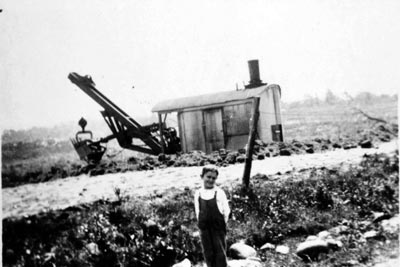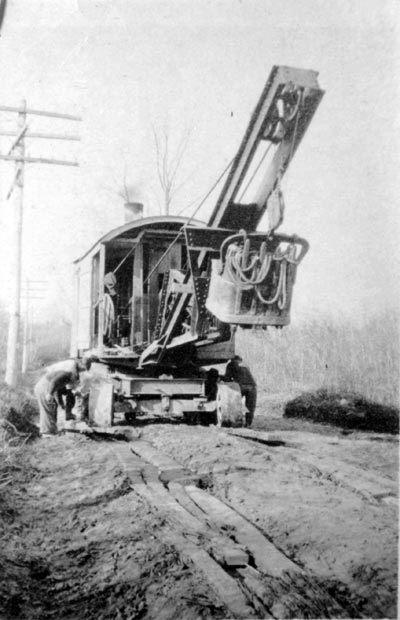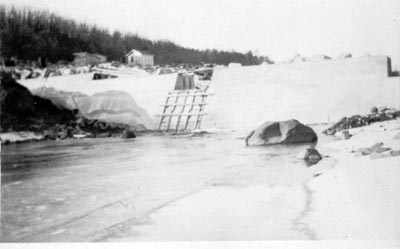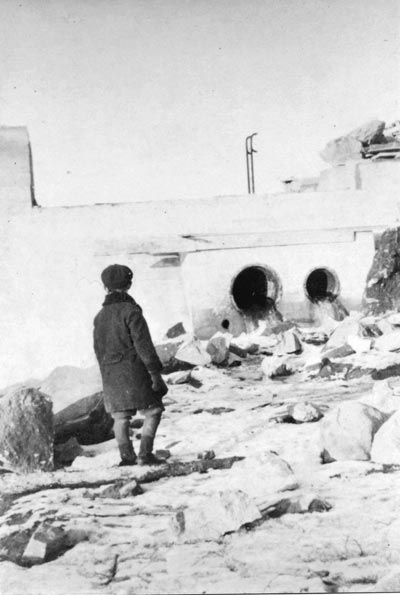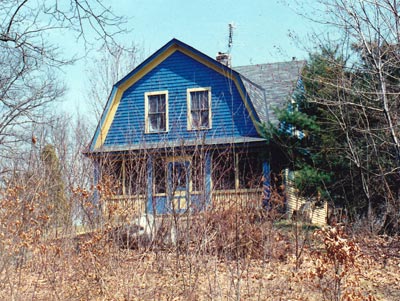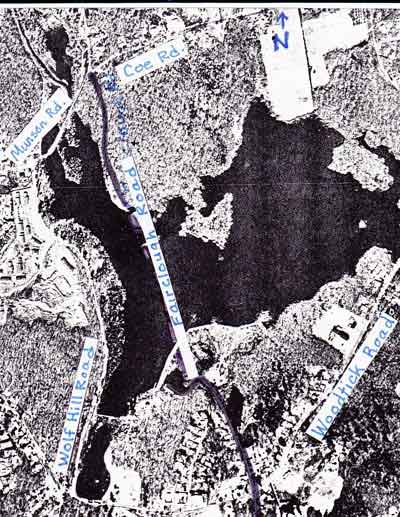|
|
||||||||||||
 |
 |
|
Wolcott Historical Society News - January 2010 By Florence Goodman This month's article will continue with the history and development of the Woodtick Reservoir and Dam, which was the focal point in the village of Woodtick.
In the early 1860s, several forward-thinking men who owned the Mad River Water Company, a Waterbury-based corporation, began to think of their future water needs. The Company began purchasing water rights in surrounding towns and Wolcott was top on their list for water storage facilities. They purchased large tracts of land, which were part of the upper Mad River watershed and by 1874, the Company had constructed three large reservoirs in town: Hitchcock Lake, Cedar Swamp, and Chestnut Hill Reservoir.
It wasn't until 1912 that the Mad River Water Company purchased additional land for the future construction of the Woodtick Reservoir. In 1917, construction of this large man-made pond began. It covered approximately 330 acres of land and was associated with the prominent Scovill Manufacturing Company, which needed large amounts of water to produce brass. The lower dam of the reservoir was referred to as the Cornelis Dam and was made of masonry and earth. This 60-foot long dam consists of double spillways; one arched and the other straight. Originally both spillways were arched.
Construction of the upper dam caused the Mad River to flood the land and form the Woodtick Reservoir. The water in the reservoir covered sections of two old roads: the present Scovill Road was originally part of Fairclough Road, which ran straight through to the intersection of Munson and Coe Roads. The dirt road where the Kiwanis Club Day Camp is located today was the other section of Fairclough Road. About 1,000 feet of Fairclough Road was covered by water with the creation of the dam. Wolf Hill Road, which runs along the west side of the reservoir, was built to replace Fairclough Road.
The lower end of Bound Line Road, just below Coe Road to the intersection of Woodtick Road replaced the older section of Bound Line Road that was also flooded by the new dam. Farm properties that belonged to Conrad Herbst, N. Hanson, and D.L. Frisbie were lost to the flooding of the land, as well as, the Timothy Root House that was on Fairclough Road.
Several interesting agreements were made between the landowners in the area and the Mad River Company when they sold property for the dam. On December 19, 1910, Emily Cornelis Teller, "reserves the right to drive livestock over any portion of land for the sole purpose of watering said livestock, and also to use the waters of the Mad River."
Another deed from Harvey W. Coe, dated April 12, 1912, stated, "Mr. Coe reserves the rights for himself and his heirs to use one rowboat on waters of the lake proposed to be formed by the erection of the dam, to fish in the waters of said lake, and to take ice from the surface of such lake for personal and domestic uses only, and to use any portion of the land not flooded, up to the water line for cutting grass and for pasturing purposes."
Mr. Joseph Winkler, who was nine years old when the dam was under construction, gave the following account of the dam's construction. He said he spent every waking moment watching the Italian workers and he learned to speak Italian as well. The following excerpts were taken from his interview.
"There were barracks where the Kiwanis Club Camp is that housed about 300 men and a store where the workmen charged their purchases to their accounts and when they got paid, they discounted what they owed the store. Everything was done with dumpcarts not trucks. Everything was operated by steam: the water pumps, the steam shovel, the derrick, and the cable car, as it was called, which dumped the cement out.
"When they built the earth dam at the end of Scovill Road, they brought all the dirt in. They built a cement core and then put earth on both sides of it. The piece of Woodtick Road (near Bound Line Road) was raised up about five feet so it wouldn't be flooded and they moved part of Bound Line Road.
"Up by Dingwell's Bike Shop and Cocoa's Garage, they had a stone crusher that made three grades of rock, that they used in the cement. On Wolf Hill Road, they had a place dug out in the rock where they blasted out the rock and used another stone crusher. They had a cement mixer operated by steam and one operated by gasoline. That dam goes as deep into the ground, practically as far as it goes above ground.
"They had one truck, a 'Kissle Kar,' that brought the cement from the railroad station in Waterbury. All cement came in a cloth bag made of linen. I used to pick up the cloth bags and take them home. My mother would rip them out, bleach them, and make dishtowels out of them. Some of those dishtowels were still around after 60 years. There were two 12' X 12' towers built of Georgia pine, one at Wolf Hill Road and one at the end of Scovill Road. They had a series of cables that they would use to bring the cement bucket out on, to wherever they wanted to dump it."
There is a small boy in one of the pictures that follow, and it could be Mr. Winkler.
The construction of the Woodtick Dam and Reservoir changed the path of the Mad River and the physical characteristics of the land around it forever. Farms, roads, pasture lands, and stonewall boundaries were lost to these floodwaters. We even lost the original site of the Wolcott Fair Grounds, which was located on Munson Road between the river and the road close to the intersection of Brooks Hill Road.
In 1936, Mr. Leslie Hart became the caretaker of the reservoir and boat dock and he and his family lived in the house located at the end of Scovill Road. Hart stated in an article from the Waterbury Republican that, "Members of Scovill Rod and Gun Club could buy a fishing permit for 50 cents."
He also stated that he received 10 percent commission for the permits and boat rentals, and he lived in the company-owned house for 50 dollars a month. Part of Hart's job was to open and close the floodgates on the dam. He said that during World War II, Scovill was making ammunition. The water from the reservoir was used in the factory and police guarded the huge cement dam to make sure it wasn't bombed. The police were stationed at the dam 24 hours a day. Hart and his family lived in the home at the end of Scovill Road for over 50 years.
In April 1985, the Scovill Manufacturing Company made an offer to Mayor Edward Wilensky for the town to purchase Woodtick and Chestnut Hill Reservoirs and Cedar and Hitchcock Lakes for a total of $3,269,000. After negotiations with Scovill, the Town held a referendum on June 11, 1986, to approve a $1.4 million bond issue to buy Woodtick Reservoir. It was approved by a 965-85 vote. The final price of the package included $740,000 for the Woodtick Reservoir, $460,000 for dam repairs required by the State DEP, and $200,000 for engineering and legal fees, and a contingency fund. As part of the purchase, which was signed on July 9, 1986, the Town was given Hitchcock Lake and Chestnut Hill Reservoir, both for "no consideration."
Sometime in 1990, the Scovill Recreation was renamed the Woodtick Recreation Area. A town-wide contest was held and the new name was chosen from many suggestions. Today, this attractive recreation area is enjoyed by town residents as well as residents from surrounding towns.
(Much of the information for this article was taken from The Woodtick Dam and Reservoir by Skye MacBroom, The History of the Town of Wolcott, Connecticut From 1731 to 1874 by Sameul Orcutt, and The 1986 Historic Resources Inventory by J.P.Loether).
Our Schoolhouse Museum is open by appointment only during the winter months. Anyone interested in visiting the Museum, please call Loretta Leonard at 203-879-4310 or Flo Goodman 203-879-9818.
Young man watching construction of the dam; it may be Mr. Winkler.
Steam shovel used to build the dam.
Woodtick Dam under construction.
Pipes under Woodtick Dam wall.
Caretaker's house.
Map is an aerial view of the Woodtick Reservoir.
To view past installments of the Wolcott Historical Society News, click here.
|
|
|
[Home]
[News]
[Purpose]
[Calendar]
[Museum]
[Membership]
[History]
[Contacts]
[Links]
All material at Wolcott Historical Society Web sites Copyright © 2000-2010 Wolcott Historical Society |
